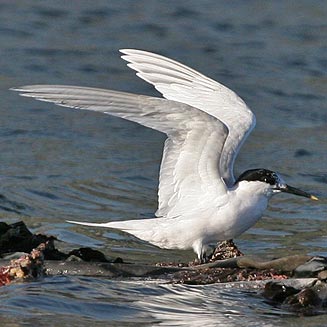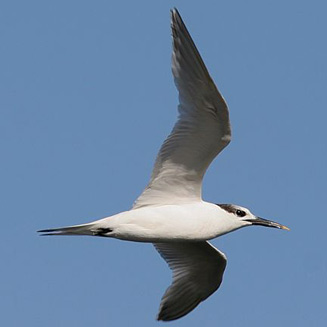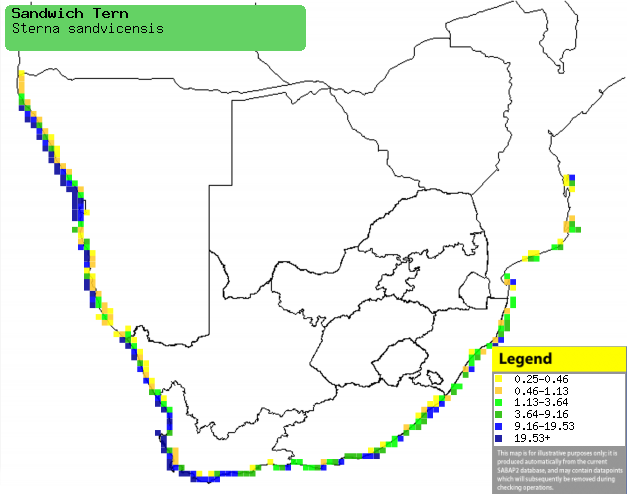|
Sterna sandvicensis (Sandwich
tern)
Grootsterretjie [Afrikaans]; Amerikaanse grote stern
[Dutch]; Sterne caugek [French]; Brandseeschwalbe [German]; Garajau
[Portuguese]
Life
> Eukaryotes >
Opisthokonta
> Metazoa (animals) >
Bilateria >
Deuterostomia > Chordata >
Craniata > Vertebrata (vertebrates) > Gnathostomata (jawed
vertebrates) > Teleostomi (teleost fish) > Osteichthyes (bony fish) > Class:
Sarcopterygii (lobe-finned
fish) > Stegocephalia (terrestrial
vertebrates) > Tetrapoda
(four-legged vertebrates) > Reptiliomorpha > Amniota >
Reptilia (reptiles) >
Romeriida > Diapsida > Archosauromorpha > Archosauria >
Dinosauria
(dinosaurs) > Saurischia > Theropoda (bipedal predatory dinosaurs) >
Coelurosauria > Maniraptora > Aves
(birds) > Order: Charadriiformes
> Family: Laridae > Genus: Sterna
 |
 |
| Sandwich tern, Kleinmond, Western
Cape, South Africa. [photo H. robertson, Iziko
©] |
Sandwich tern, Strandfontein Sewage Works, South
Africa. [photo Trevor Hardaker ©] |
Distribution and habitat
Breeds from western Europe to the Caspian Sea and North
America, heading south in the non-breeding season to South America, the Arabian
Sea and the coast of Africa. It is common along
the coastline of southern Africa, especially in Namibia and western South Africa,
generally preferring mixed sandy and rocky shores.
|
 |
|
Distribution of Sandwich tern in southern Africa,
based on statistical smoothing of the records from first SA Bird Atlas
Project (©
Animal Demography unit, University of
Cape Town; smoothing by Birgit Erni and Francesca Little). Colours range
from dark blue (most common) through to yellow (least common).
See here for the latest distribution
from the SABAP2. |
Movements and migrations
Palearctic breeding migrant, travelling down
the west coast of Africa, getting to the Western Cape in September,
after which it travels east, reaching Mozambique in December. It
departs the earliest in the east, in late January and early
February, while it leaves Namibia in April.
Food
It mainly eats pelagic fish, crustaceans and molluscs,
foraging by flying over the sea with its head pointed downwards; if prey is
spotted, it momentarily hovers before plunge-diving from 5-10 metres above the
water.
Breeding
Technically southern Africa forms part of its non-breeding
grounds, however in 2002 birds in the Western Cape were reported performing courtship displays, such
as synchronised flying, calling in flight and allo-feeding, in the period from February-May at Koeberg, Dassen Island and Shaapen
Island. At Robben Island a pair were reported to feed a chick; all this suggests that
Sandwich tern either bred or attempted to breed in southern Africa in 2002.
Threats
Not threatened.
References
-
Hockey PAR, Dean WRJ and Ryan PG 2005. Roberts
- Birds of southern Africa, VIIth ed. The Trustees of the John Voelcker
Bird Book Fund, Cape Town.
|
